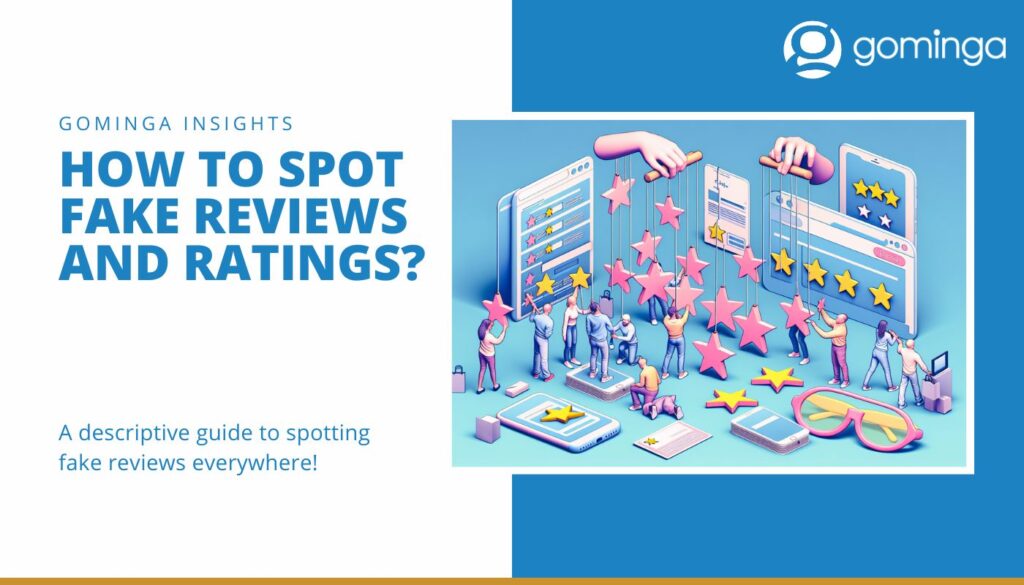
In today’s digital age, many consumers rely on online reviews and ratings to make informed decisions about a product or service. Positive reviews and five-star ratings can greatly influence a potential customer’s choice. However, not all reviews written are genuine, and some may be fake, posted to manipulate public perception. This practice is not only unethical but can also mislead consumers. As a savvy online shopper, learning how to spot fake reviews is essential. Identifying red flags and distinguishing authentic feedback from fabricated opinions is crucial.
What is The First Step to Spot Fake Reviews
To spot a fake review, looking for patterns in a product’s positive and negative reviews is important.
Fake positive reviews of products tend to be overly enthusiastic, lacking specific details about the product or service. They may also be written in a similar style or use the same phrases, indicating that they were generated by the same person or group.
On the other hand, fake negative reviews often contain exaggerated claims or focus on irrelevant aspects of the product or service. Pay attention to the rating distribution when shopping online and browsing the product reviews section.
Genuine reviews typically have a mix of positive and negative customer feedback, reflecting the diverse experiences of real customers. If a product has an overwhelming number of five-star reviews with few or no critical comments, it may be a sign that the reviews are not authentic.
Another flag for unreal reviews is a sudden influx of reviews within a short period, especially if the product or service has been available for a while. This could indicate that someone artificially buys phoney reviews to boost their ratings.
In this article, we will explore various ways to identify and avoid falling victim to fake online reviews and ratings, ensuring that you make well-informed decisions based on genuine experiences shared by real customers.
Do Two-thirds of All Products Really Have a Star Rating That Is Too Good?
There are more and more articles about fake reviews in the press and on various online news portals. This refers to various industries and their internet platforms, from gastronomy to travel to search engines. Mostly, it is about Booking.com, Tripadvisor, and Google. And, of course, about Amazon.
Interestingly, there is only some specialist literature or studies on the subject. Everyone knows that there are “fake” or purchased reviews; however, the extent and impact have been poorly documented.
The pioneers in uncovering and combating ” unreal reviews ” are usually consumer protection organizations or similar players. In the UK, this is “Which?”; for example, it is Stiftung Warentest in Germany.
As review experts, we at gominga are, of course, also intensively concerned with the topic of false reviews to provide our customers with advice and support.
Here, we would also like to refer to the chapter “Product Reviews on Amazon: Relevance and Recommendations for Companies” in the book “Amazon für Entscheider” (Springer Verlag, April 2020).
In the following sections, we have taken a recent article from Stiftung Warentest as an opportunity to examine the topic of “phoney reviews” and the procedure for identifying if a user review is fake. To do this, we used the analysis tool provider ReviewMeta analogously to evaluate Stiftung Warentest and applied an additional comparison evaluation with further review data.
In addition to our findings, we also provide further links on the topic, including current studies by “Which?” from the UK and Stiftung Warentest.
For several years, national and international studies have been conducted to prove the influence of reviews on consumers. We, too, have explained the value of customer reviews comprehensively.
A connection between reviews, price, and sales is often demonstrated. Therefore, it is understandable to a certain extent that there are attempts to influence the business positively by manipulating reviews.
Unreal reviews have become more and more common in attracting customers.
Fake reviews are most effective for lesser-known brands, products with few technical attributes, and low-priced items. Manipulators target star ratings, review quantity, rating distribution, and high-quality fake reviews. While platforms implement strict rules, manipulation persists through various means, from family and friends to a professional shadow industry using social media groups, payment services, bots, and review hijacking. Stiftung Warentest’s 2020 report detailed these practices, including buying reviews and analyzing them with ReviewMeta.
We used the report as an opportunity to examine the methodology, procedure closely, and results to compare them with another data set and replicate the analysis.
“The question and goal for us was: can you really easily identify reviews that have been bought? What is the percentage of reviews bought, and is there a difference between branded products and “no name”
Ways to Spot Fake Reviews
How can you recognize purchased reviews? What are the criteria? How can such a testing process be automated for large amounts of data?
One effective way to realise non-decent reviews is to identify patterns or similarities across multiple reviews for products.
If you notice that many reviews use similar language, phrasing, or specific keywords, it could be a sign that they are fake.
This is especially true if the reviews are posted within a short timeframe or if they are overly positive or negative without providing specific details.Also, pay attention to the name of the review writer. Unreal reviews tend to be written by profiles with generic names such as John Smith or Jane Doe.
Another red flag is a sudden influx of 5 stars or one-star reviews, particularly if they deviate significantly from the overall rating trend.
Genuine reviews tend to have a more balanced distribution of ratings. Numerous similar reviews could be fake as well.
Additionally, be cautious of reviews mentioning the review writer received a free product in exchange for feedback. While some companies do offer incentives for honest reviews, an unusually high number of such mentions could be a sign of fake reviews.
ReviewMeta is one of the most prominent tools on the market for identifying suspicious reviews on Amazon. The company first collects rating data from the various Amazon country platforms and then subjects it to an authenticity check.
For example, there are currently 5.3 million checked products on amazon.com and almost 650,000 products on amazon.de
of course, this means that it is a static check and not all current data can always be queried. In addition, the very large amount of data does not include all products and their reviews.
ReviewMeta mostly evaluates the top 100 products of different categories. These topseller lists then contain – sometimes more, sometimes less – a mixture of products from well-known brand manufacturers and low-priced no-name producers.
The tool is free, so anyone can query individual products and check for fake product feedback either at ReviewMeta directly or through a browser plugin. Finally, it should be mentioned that ReviewMeta doesn’t talk about “unreal reviews”; rather, it says, “ReviewMeta analyzes Amazon product feedback and filters out reviews that our algorithm detects may be unnatural.”
“ReviewMeta itself doesn’t talk about “fake reviews,” but rather, “ReviewMeta analyzes Amazon product reviews and filters out reviews that our algorithm deems unnatural.”
What Did gominga Investigate?
We used ReviewMeta’s tool to analyze and compare two different review datasets. The first test group comprises 45 products for which we know of purchased or “incentivized” reviews.
The second test group includes 110 products from brand manufacturers without purchased or “incentivized” reviews. All well-maintained assortments with consistently organically generated reviews and active customer support that responds to negative reviews and answers questions.
So our question was:
- Does ReviewMeta recognize purchased reviews?
- How many reviews does ReviewMeta mark as “unnatural”?
- How does the star value change after ReviewMeta sorts out “unnatural” reviews?
We were also interested to see if there was a difference between inexpensive, no-name products (often cell phone cases, accessories, cables, water bottles, etc.) and the products of brand-name manufacturers.
Calculating the star value is important for the analysis and the results. Both ReviewMeta and we can only calculate this using the arithmetic mean of the ratings. Amazon, on the other hand, uses an algorithm that considers various unknown factors. Therefore, there is usually a considerable discrepancy between the star value displayed on Amazon and the calculated value.
Amazon explains the calculation of the star value as follows:
“These models consider several factors, including, for example, how recent the review is or whether it is a verified purchase. They use multiple criteria to determine the authenticity of the feedback. The system continues to learn and improve over time. We do not consider customer reviews that do not have “Verified Purchase” status in the overall star-based rating of products unless the customer adds further details in the form of text, images, or videos”.
Both we and ReviewMeta only consider evaluations with text in our calculations. Although verified pure ratings without text are included in the overall average, these cannot currently be recorded externally, neither for us nor for ReviewMeta. These can only be determined by comparison if the product has already been recorded.
ReviewMeta Review Criteria and Process
ReviewMeta’s processes all ratings using a variety of criteria by which either the rating or the writer is deemed ‘untrustworthy’ – these are:
Author:
- Brand Repeaters
- Brand Loyalists
- Brand Monogamists
- Never-Verified Users
- One-Hit Wonders
- Overlapping Review History
- User Participation
- Single-Day Users
- Take-Back Users,
Rating:
- Deleted Reviews
- Incentivized Reviews
- Phrase Repetition
- Unverified Purchases
- Word Count Comparision
ReviewMeta categorizes reviews as “FAIL,” “WARN,” or “PASS” based on detected anomalies. Our analysis focused on “FAIL” results. However, ReviewMeta’s scans are infrequent, with some products never recorded or last scanned months ago. Some evaluations rely on only a few scans, making conclusions tentative, especially for criteria like deleted reviews that require current data.
Our analysis of the two test groups examines star value adjustments, suspicious rating numbers, and the main criteria for “unnatural” ratings.
Adjustment of the star value
As far as sorting out the “unnatural” ratings and, thus, recalculating the star value, the relationship between the two evaluated groups is largely similar. The difference between the “old” star value displayed on Amazon and the “new” star value has changed similarly in both groups.
Changes in the first decimal place make up the largest share.
Between almost 73% (test group with “incentivized” ratings) and 62% (test group of branded products) show a change of less than 0.5 and thus usually below the rounding limit for the graphically displayed star on Amazon. Of these, between 23% and 19% are even below 0.1.
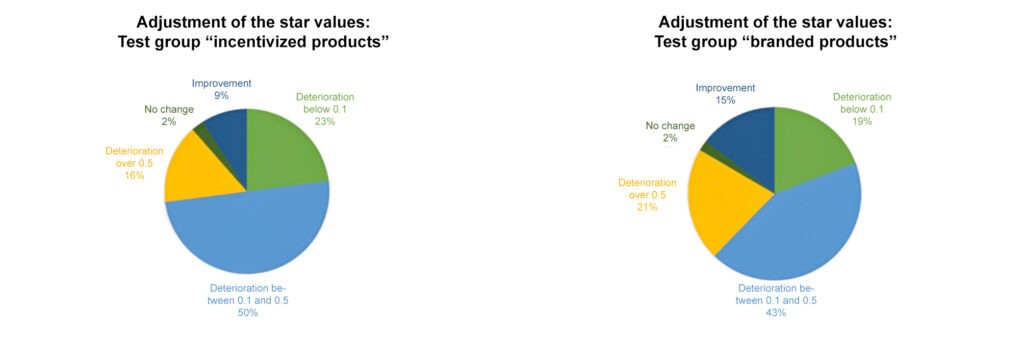
This adjustment is largely due to the different calculations by the star value shown on Amazon and the arithmetic mean of the recalculation.
For the products evaluated here, the fewest reviews (compared to the other clusters) were completely sorted out by ReviewMeta’s rules, i.e., the smallest adjustment occurred here.
At 16% for the test group with “incentivized” ratings and 21% for the products of the brand manufacturers, a larger change in the star value of over 0.5 can be determined. This would then result in a change in the graphical representation of the star value on Amazon. For example, 4 full stars are then displayed instead of 4 ½.
In 9% of the products with “incentivized” ratings and 15% of the products of brand manufacturers, the adjustments made by ReviewMeta even led to improvements in the rating. In other words, negative ratings are identified as “unnatural”.
There are no changes at all in 2% of the products.
Adjustment of the number of product reviews
The products in the test group with “incentivized” ratings had an average of 41 ratings before analysis by the ReviewMeta tool. The test group of branded products had 423.
There are many reasons for this. It could be argued that branded products are inherently better known among consumers and are, therefore, rated more often.
Furthermore, the product presentations of the brand manufacturers are presumably better maintained, and the topic of reviews and Q&A is actively managed.
On the other hand, the products in the test group with “incentivized” reviews have significantly fewer reviews, which is the original reason for buying reviews in the first place.
Sorting out and adjusting the quantitative number of reviews naturally leads to the possibility of finding many made-up reviews, which is consistently unequal for the two test groups.
In the test group with “incentivized” reviews, 61% had no changes at all in the number of reviews, i.e., 61% had no complaints at all or these did not lead to exclusion. In the case of branded products, this only affected 16%.
The Main Criteria of the Ratings Identified as “Unnatural”
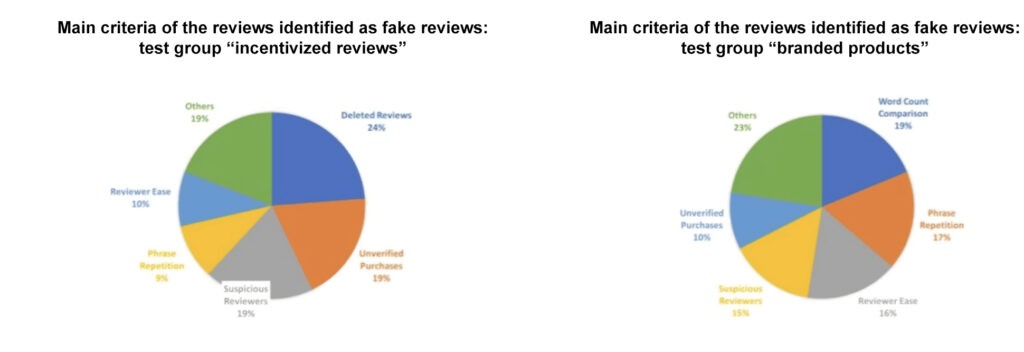
This adjustment is largely due to the different calculations by the star value shown on Amazon and the arithmetic mean of the recalculation.
For the products evaluated here, the fewest reviews (compared to the other clusters) were completely sorted out by ReviewMeta’s rules, i.e., the smallest adjustment occurred here.
At 16% for the test group with “incentivized” ratings and 21% for the products of the brand manufacturers, a larger change in the star value of over 0.5 can be determined.
This would then result in a change in the graphical representation of the star value on Amazon. For example, 4 full stars are then displayed instead of 4 ½.
In 9% of the products with “incentivized” ratings and 15% of the products of brand manufacturers, the adjustments made by ReviewMeta even lead to improvements in the rating. In other words, negative ratings are identified as “unnatural”.
There are no changes at all in 2% of the products.
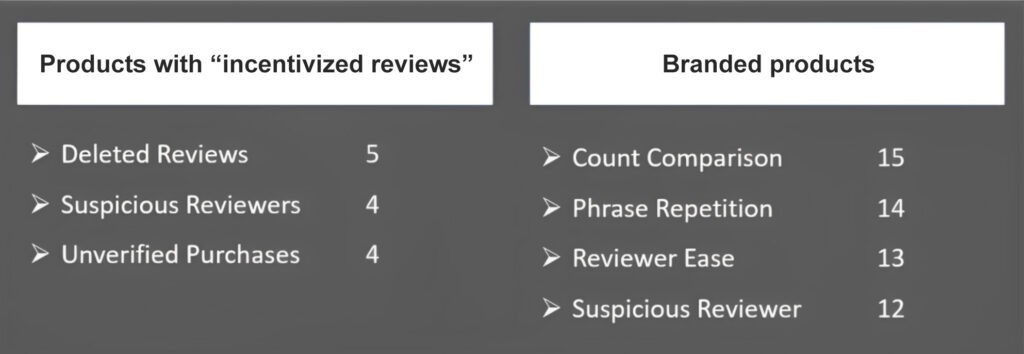
Deleted Reviews
ReviewMeta analyzes the reviews of the respective product at irregular intervals. If ReviewMeta determines that a previously published review is no longer available, it is considered as a “Deleted Review”. ReviewMeta does not know why the respective review was deleted. If many reviews are deleted, this behaviour is considered dubious for ReviewMeta.
However, there are numerous reasons for Amazon to delete a review or not to allow it at all:
”[…] References to pricing, product availability or alternative ordering options should not be mentioned in customer reviews or under questions and answers.” And “Customer reviews and Q&As should refer to the specific item. Feedback about Marketplace sellers or shipping issues can be provided [elsewhere]”.
(Source: Amazon)
For example, if a review criticizes shipping or marketplace merchants, Amazon will remove such a review.
Suppose the manufacturer or its customer support is active on Amazon and forces the deletion of such unsuitable reviews. In that case, this brings the product minus points according to the criteria of ReviewMeta.
Amazon also deletes reviews if there is a clear reference to product tests and it is not Amazon’s own Vine program.
However, personal data or references to other shops also lead to the deletion, all of which are criteria that do not allow any statement to be made about the authenticity of the rating. In contrast, the number of reviews that are deleted by the user himself is, in our experience, insignificant.
And again, the note about the data collection by ReviewMeta: The calculation of deleted reviews at ReviewMeta is based solely on a ‘before and after’.
In other words, a statement about deleted reviews can only be drawn if the same product has already been recorded before and a review with a certain timestamp is missing in the next scan – as ReviewMeta itself explains:
” We don’t have a magic ability to collect every single deleted review; we can only identify reviews as deleted if we collect them on one date and then notice they are no longer visible on a subsequent date.”
Source: ReviewMeta
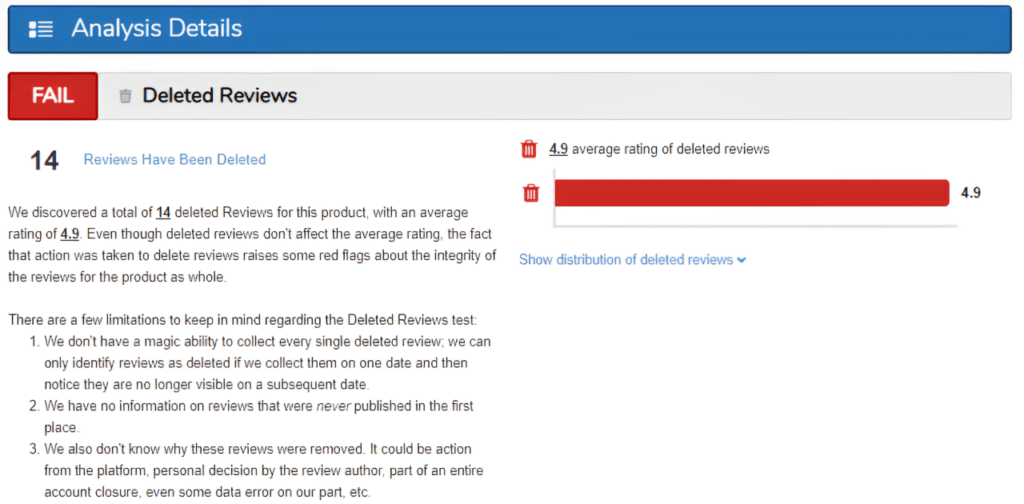
Suspicious Reviewers
ReviewMeta differentiates between four different cases: “One-Hit Wonders”, “Single-Day Reviewers”, “Never-Verified Reviewers” and “Take-Back Reviewers”. This is, for example, a person for whom at least one of the reviews submitted has been deleted.
”[An amount of] review writers have had at least one of their past reviews for another product deleted. This is an excessively large percentage of Take-Back Reviewers which may indicate unnatural reviews.”
Source: ReviewMeta
Unverified Purchases
ReviewMeta classifies reviews as “unnatural” without prior purchase of the product on Amazon.
Reviews without a previous, verified purchase will be restricted by Amazon. Even if the frequently cited Amazon rule that customers “[…] can write up to 5 reviews per week that are not marked with the addition “verified purchase” has currently disappeared from the guidelines, the option of submitting reviews remains cannot be assigned to a purchase, and only an “unverified” rating can be given if verified ratings are also used more frequently.
However, if a product has many unverified reviews, Amazon reserves the right to block this product from reviewing activity.”
Apart from that, various portals also offer incentivized verified reviews. Whether the criterion Unverified Purchases is a unique identifier for a “purchased” valuation cannot be clearly justified from our point of view.
Word Count Comparison
This criterion shows an accumulation of evaluations with a certain length, i.e., number of words. ReviewMeta measures the length of a review text and then compares it with other reviews of comparable products.
A ‘FAIL’ for this criterion means that many ratings for this product have a certain number of words, e.g., between 6 and 15.
The following graphics illustrate the “Word Count Comparison” criterion and show ratings with 6 to 15 words.
The examples on the Amazon site are organically generated reviews from verified purchases. It remains questionable whether such an assessment can be classified as “unnatural” due to the length of the text.
Phrase Repetition as a Red Flag
ReviewMeta is looking for an accumulation of certain words and expressions here. Our evaluation shows that there are seldom references to product tests, but terms such as “quality” and “price” or “am satisfied” are mentioned particularly often.
According to our observation, this corresponds to the average evaluation vocabulary and is not yet an abnormality in itself.
In the data set of the test group of the “incentivized” products, the expression “was made available to me free of charge for test purposes” was found in only one evaluation. The other hits related to “quality”, “price” and “design”.
Reviewer Ease
This is the observation that a reviewer has a particularly good overall average of his reviews, i.e., the reviews usually have 4 or 5 stars.
Brand Repeats & Overlapping Review History
The criteria brand repeats (with only 1% corresponding to 1 hit) or overlapping review history (with 6% corresponding to 5 hits) are only found relatively rarely.
Behind the terms, there are, on the one hand, evaluators who rate products from one and the same brand more frequently and, on the other hand, different evaluators who often rate identical products over the same period of time.
This suggests a pool of evaluators from a product testing agency. However, it is precisely these relatively unique identifiers that can only very rarely be registered.
gominga’s Conclusion – it Remains Difficult to Spot Fake Reviews
Online reviews influence purchasing decisions, but fake reviews are a concern. These can be posted by businesses, competitors, or hired individuals to manipulate opinions. To spot fake reviews you might need to:
- Examine language, posting frequency, and reviewer profiles
- Look for specific details and balanced opinions
- Be wary of overly positive/negative reviews or those lacking substance
- Watch for review bursts or similar wording
Identifying fake reviews is challenging, even with tools like ReviewMeta. Criteria are often ambiguous, and differences exist between product groups.
Our analysis couldn’t confirm most reviews are fake or that products are overrated. Only about 25% of analyzed products showed better ratings than Amazon’s calculation method suggested, usually below the rounding limit.
